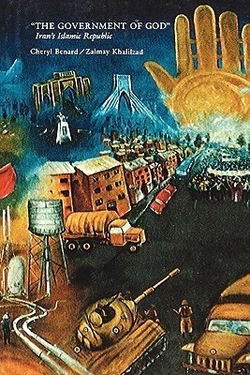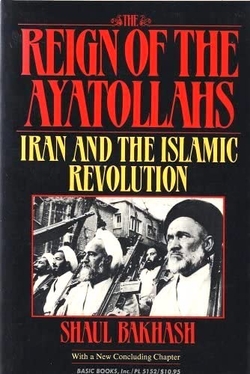 The Islamic revolution that engulfed Iran in 1978-79 caught most Middle East specialists completely by surprise. Why? Cheryl Benard and Zalmay Khalilzad consider this question at the start of their eclectic book, The Government of God: Iran's Islamic Republic (Columbia University Press, 232 pages, $25). Their answer could help predict radical changes in other countries that appear deceptively stable, such as Morocco or Tunisia today.
The Islamic revolution that engulfed Iran in 1978-79 caught most Middle East specialists completely by surprise. Why? Cheryl Benard and Zalmay Khalilzad consider this question at the start of their eclectic book, The Government of God: Iran's Islamic Republic (Columbia University Press, 232 pages, $25). Their answer could help predict radical changes in other countries that appear deceptively stable, such as Morocco or Tunisia today.
During the rule of the shah, Western analysts from both the mainstream and the left misgauged the political currents, although for different reasons. The mainstream—both liberals and conservatives—succumbed to the happy illusion that Iran was Westernizing smoothly. They ignored its building tensions, they "failed to note the continuing social and political role of the religious leaders; they overestimated the popular support given to the shah's rule; they underestimated the continuing and in some regards even growing social problems." In the authors' view, Washington's good relations with the Iranian government and sympathy for the shah's efforts strengthened the illusion of calm.
Analysts on the left made the opposite mistake. They judged Iranians to be the passive victims of imperialism, unable to resist their government. The left foresaw no shake-up in Iran so long as the shah kept the support of major foreign powers, as he did until very late in his rule.
Whatever their reasons, however, almost all analysts mistakenly assumed that Iran (and all non-Western societies) would increasingly resemble the West. They therefore expected a long, stable rule for the shah, and underestimated the power of the religious opposition.
The premise that Europeans and Americans have blazed the only possible road to modernization diverted attention from the growing conflicts in Iran. In particular, Islamic religion clashed with Western ways. Many pious Iranians were deeply upset, for example, that the shah's regime had turned away from the Islamic regulations on separation of the sexes.
For the future, the authors imply, foreign observers should be more wary of their own biases and preconceptions. Assessments should not be based on political sympathy. Also, the path to modernization must be broadened enough for women in veils as well as in jeans—and even for ayatollahs.
 The role of ayatollahs is precisely the topic of Shaul Bakhash in his excellent study, The Reign of the Ayatollahs: Iran and the Islamic Revolution (Basic Books, 276 pages, $18.95). Mr. Bakhash, a former newspaper editor in Tehran, gives a solid, dispassionate account of conflicts among the shah's successors in Iran from early 1979 to late 1952.
The role of ayatollahs is precisely the topic of Shaul Bakhash in his excellent study, The Reign of the Ayatollahs: Iran and the Islamic Revolution (Basic Books, 276 pages, $18.95). Mr. Bakhash, a former newspaper editor in Tehran, gives a solid, dispassionate account of conflicts among the shah's successors in Iran from early 1979 to late 1952.
While Khomeini had all along intended to establish an Islamic government, few of his partners in revolution shared this aim. "It was only after they had seized power that the revolutionaries confronted the problem of creating the Islamic, socialist, Marxist, or democratic state they had been advocating." Differences between these four visions for Iran emerged most clearly in the debate over a new constitution for the nation. "The basic split centered not on economic, foreign, or even social policy but on political arrangements and on the role of Islam in the republic."
Although hard to see from the outside, these issues drove Iranian politics. To take one well-known example, the mobs at the U.S. embassy in Tehran, which seemed purposelessly fanatical when shown on American television, actually had a critical role in the power struggle. As Mr. Bakhash shows, the embassy takeover benefited Khomeini's radical Islamic following by tainting anyone in favor of normal relations with Washington.
The Islamic radicals also won the struggle over Iran's constitution in October 1979, installing Khomeini as vice regent, an immensely powerful position accountable to no mortal (the regent being God). Then another split occurred over the issue of rural land reforms, and again the more radical view prevailed.
The victory of the most extreme faction in Iran has done great harm to both Iranian citizens and U.S. interests. Iranians must contend with a regime that is arguably as totalitarian as the governments of the Soviet bloc. The U.S. has lost an ally, and now faces the twin dangers of Iranian hostility toward Americans (resulting in repeated outrages such as the possible Iranian collusion in the recent hijacking of a Kuwaiti airplane) and heightened Soviet ambitions with regard to the Persian Gulf.
Mr. Bakhash does salvage one glimmer of hope from the victory of the Islamic radicals. To choose the next vice regent after Khomeini dies, they have established a mechanism for the transfer of power: the Assembly of Experts. As a result, there is now a reasonable chance "of a fairly orderly succession." This greater stability makes Soviet intervention in Iran less likely.
Although a number of excellent books on Iran have appeared in recent years, these two bring some new insights to the field. The second of these studies helps explain the disaster that has taken place. The first could help prevent it from happening again.